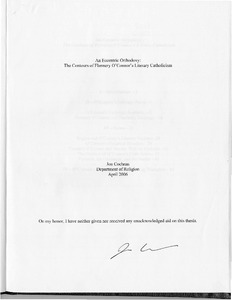| dc.rights.license | In Copyright | en_US |
| dc.creator | Cochran, Jonathan Lee | |
| dc.date.accessioned | 2023-10-20T15:49:27Z | |
| dc.date.available | 2023-10-20T15:49:27Z | |
| dc.date.created | 2006 | |
| dc.identifier | WLURG038_Cochran_thesis_2006 | |
| dc.identifier.uri | https://dspace.wlu.edu/handle/11021/36266 | |
| dc.description.abstract | Some of O'Connor's characters come right out and ask traditional theological questions about the suffering of the innocent or the difficulties inherent in the doctrine of bodily resurrection. Other characters, meanwhile, are made to represent certain heresies like the Manichean separation of spirit and matter or what O'Connor's sees as Protestantism's attempt to have Christianity without Christ. The questions of theology and religious doctrine pervade her work, and it thus becomes fair to ask if her treatment of these questions is in keeping with accepted Catholic tradition. Is O' Connor, that is to say, practicing orthodoxy in her fiction, or heresy? This paper addresses the question of O' Connor's orthodoxy by looking at those places where her version of Catholicism seems most divergent from common practice but stops short of trying to firmly define O'Connor as orthodox or heretical. Rather the paper attempts to identify different threads in O'Connor's work, some clearly based on accepted Catholic tradition and others that seem distinctively her own. With regard to the oddities of O'Connor's version of Christianity, a few overriding questions are asked: Where did this apparent eccentricity come from? Specifically, does it stem from a distinctive reading of Catholic tradition? In what ways are O'Connor's apparent eccentricities a product of her medium as a writer of fiction or of her desire to affect her audience in certain ways? The first section of the paper deals with O'Connor's form -- how it compares to
more conventional theology structured around arguments and how it is intended to affect the reader. It is there also that I explore Sallie McFague TeSelle's idea of parabolic theology, which suggests that O'Connor's form is a common and even orthodox way of addressing theological concerns within the Catholic tradition. The second and third sections focus on those places where O'Connor's fiction seems furthest from traditional Catholic doctrine. In the second section, I examine the action of grace in O'Connor's fiction with particular focus on the surprising link of grace
and violence in the stories. I take this strange combination as the most unusual aspect of O'Connor's version of Christian reality, and as such, it receives the most elaborate consideration. The third section broaches the question of O' Connor's portrayal of humanity and creation, places where her negativity has often led to charges of Protestantism or even nihilism, and then moves on to offer a few concluding thoughts My hope is that this paper will embody an alternative to what I see as the myopic approach of many of O'Connor's critics, who too often point to a single aspect of O'Connor's situation or aesthetic philosophy as if it alone held the key to explaining the odd look of her fiction and the strangeness of her version of Catholicism. I contend that O'Connor's work is too complex to be reduced to any single common denominator and that the unusual aspects of her portrayal of Christian reality are best understood through a multifaceted approach that considers not only O'Connor's historical and geographic situation but also her unconventional reading of parts of the Catholic tradition and her almost prophetic desire to impact the way her audience sees the world. [From Introduction] | en_US |
| dc.format.extent | 54 pages | en_US |
| dc.language.iso | en_US | en_US |
| dc.rights | This material is made available for use in research, teaching, and private study, pursuant to U.S. Copyright law. The user assumes full responsibility for any use of the materials, including but not limited to, infringement of copyright and publication rights of reproduced materials. Any materials used should be fully credited with the source. | en_US |
| dc.rights.uri | http://rightsstatements.org/vocab/InC/1.0/ | en_US |
| dc.subject.other | Washington and Lee University -- Honors in Religion | en_US |
| dc.title | An Eccentric Orthodoxy: The Contours of Flannery O'Connor's Literary Catholicism | en_US |
| dc.type | Text | en_US |
| dcterms.isPartOf | WLURG038 - Student Papers | en_US |
| dc.rights.holder | Cochran, Jonathan Lee | en_US |
| dc.subject.fast | O'Connor, Flannery -- Criticism, interpretation, etc. | en_US |
| dc.subject.fast | Religion in literature | en_US |
| dc.subject.fast | Christianity and literature -- Southern states | en_US |
| local.department | Religion | en_US |
